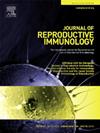Follicular fluid cytokine phenotypes reflect underlying etiologies for infertility
IF 2.9
3区 医学
Q3 IMMUNOLOGY
引用次数: 0
Abstract
To determine if the follicular fluid (FF) cytokine phenotype reflects underlying etiologies for infertility and oocyte/embryo quality. The study subjects comprised infertile women with diminished ovarian reserve (DOR, n = 42), tubal factor infertility (TFI, n = 72), and repeated implantation failures (RIF, n = 15). Controls were women with male factor infertility (MFI, n = 30). Tumor necrosis factor-α (TNF-α), interferon-gamma (IFN-γ), IL-4, IL-10, IL-17, and transforming growth factor beta1(TGF-β1) levels in the FF were measured by the enzyme-linked immunosorbent assay (ELISA). The results showed that TNF-α and TGF-β 1 levels in the DOR group were higher than in the MFI group (P = 0.028, P = 0.031, respectively). The IFN-γ/IL-4 and IFN-γ/IL-10 ratios were significantly lower in the TFI group. (P = 0.026, P = 0.016, respectively) than in the MFI group. TNF-α and IL-17 levels and TNF-α/IL-10 ratios in the RIF group were higher in the RIF group than in the MFI (P = 0.006, P = 0.002, P = 0.009, respectively). All six cytokine levels in the high-quality cleavage stage embryo group tend to be higher than those in the low-quality cleavage stage embryo group regardless of their underlying etiologies (P > 0.05). The FF cytokine phenotype may reflect the underlying immunopathology of infertile women undergoing ART cycles. DOR is associated with elevated FF TNF-α and TGF-β1, which may participate in the progression of DOR. FF of TFI has Th2 bias, while Th1 and Th17 bias was present in FF of RIF. Decrease FF cytokine levels may predict reduced oocyte/embryo quality.
卵泡液细胞因子表型反映不孕症的潜在病因
确定卵泡液(FF)细胞因子表型是否反映不孕和卵母细胞/胚胎质量的潜在病因。研究对象包括卵巢储备减少(DOR, n = 42)、输卵管因素不孕(TFI, n = 72)和反复植入失败(RIF, n = 15)的不孕妇女。对照组为男性因素不孕的女性(MFI, n = 30)。采用酶联免疫吸附法(ELISA)检测FF中肿瘤坏死因子-α (TNF-α)、干扰素-γ (IFN-γ)、IL-4、IL-10、IL-17和转化生长因子β1 (TGF-β1)水平。结果显示DOR组TNF-α和TGF-β 1水平高于MFI组(P = 0.028,P = 0.031)。TFI组IFN-γ/IL-4和IFN-γ/IL-10比值显著降低。(P = 0.026,P = 0.016)。RIF组TNF-α和IL-17水平及TNF-α/IL-10比值高于MFI组(P = 0.006,P = 0.002,P = 0.009)。高质量卵裂期胚胎组的6种细胞因子水平均高于低质量卵裂期胚胎组(P >; 0.05)。FF细胞因子表型可能反映了接受ART周期的不孕妇女的潜在免疫病理。DOR与FF TNF-α、TGF-β1升高相关,可能参与DOR的进展。TFI的FF存在Th2偏置,而RIF的FF存在Th1和Th17偏置。FF细胞因子水平降低可能预示卵母细胞/胚胎质量降低。
本文章由计算机程序翻译,如有差异,请以英文原文为准。
求助全文
约1分钟内获得全文
求助全文
来源期刊
CiteScore
6.30
自引率
5.90%
发文量
162
审稿时长
10.6 weeks
期刊介绍:
Affiliated with the European Society of Reproductive Immunology and with the International Society for Immunology of Reproduction
The aim of the Journal of Reproductive Immunology is to provide the critical forum for the dissemination of results from high quality research in all aspects of experimental, animal and clinical reproductive immunobiology.
This encompasses normal and pathological processes of:
* Male and Female Reproductive Tracts
* Gametogenesis and Embryogenesis
* Implantation and Placental Development
* Gestation and Parturition
* Mammary Gland and Lactation.

 求助内容:
求助内容: 应助结果提醒方式:
应助结果提醒方式:


